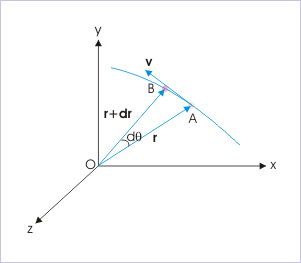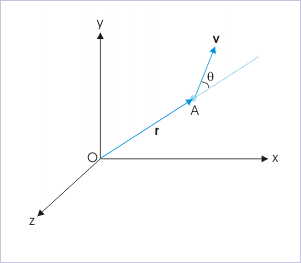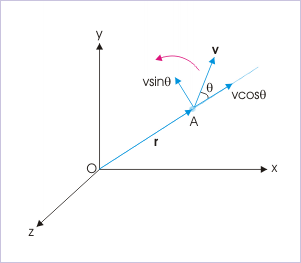| << Chapter < Page | Chapter >> Page > |
Instantaneous angular velocity is obtained by taking the limit when time interval tends to become zero. In other words, the instantaneous angular velocity (simply referred as angular velocity) is equal to the first differential of angular displacement with respect to time :
Angular velocity

It is convenient to consider the point as the origin of the coordinate system. In the figure above, origin serves as the point about which angular displacement and velocity are defined. Now since angle is measured with respect to origin, the measurement of angular velocity, in turn, will depend on the coordinate system chosen for the measurement. Further note that the linear distance of the particle from the origin is not constant like in circular motion.
In the case of circular motion about an axis, we have seen that linear velocity of a particle is related to angular velocity by the vector relation given by :
In the case of rotation about a fixed axis, the plane of velocity and position vector is same. This is not necessary for motion of a particle about any arbitrary point. The position vector and velocity can be oriented in any direction. It means that plane of motion can be any plane in three dimensional coordinate system and is not constrained in any manner.
Interpretation of the vector equation as given above is difficult for the motion of a particle along a path, which is not circular. We observe that angular velocity is an operand of the cross product. What we mean to say that it is not the vector, which is expressed in terms of other vectors. By looking at the vector relation, we can say that linear velocity is perpendicular to the plane formed by angular velocity and position vector. From the point of view of angular velocity, however, we can only say that it is perpendicular to linear velocity, but it can have any orientation with respect to position vector. This presents difficulty in interpreting this relation for angular velocity about a point.
Here, we consider a situation as shown in the figure. We see that velocity of the particle and the position vector form an angle, "θ" between them. For convenience, we have considered the point about which angular velocity is defined as the origin of coordinate system.
Angular velocity

To analyze the situation, let us consider components of velocity in the radial and tangential directions.
Angular velocity

The radial component of velocity is not a component for rotation. Its direction is along the line passing through the origin. The rotation is accounted by the component of velocity perpendicular to position vector. Now, tangential velocity is perpendicular to position vector. Thus, we can use the fact that instantaneous angular velocity is equal to ratio of tangential velocity and linear distance from the origin (as defined for circular motion about an axis). Hence, the magnitude of angular velocity is given as :

Notification Switch
Would you like to follow the 'Physics for k-12' conversation and receive update notifications?